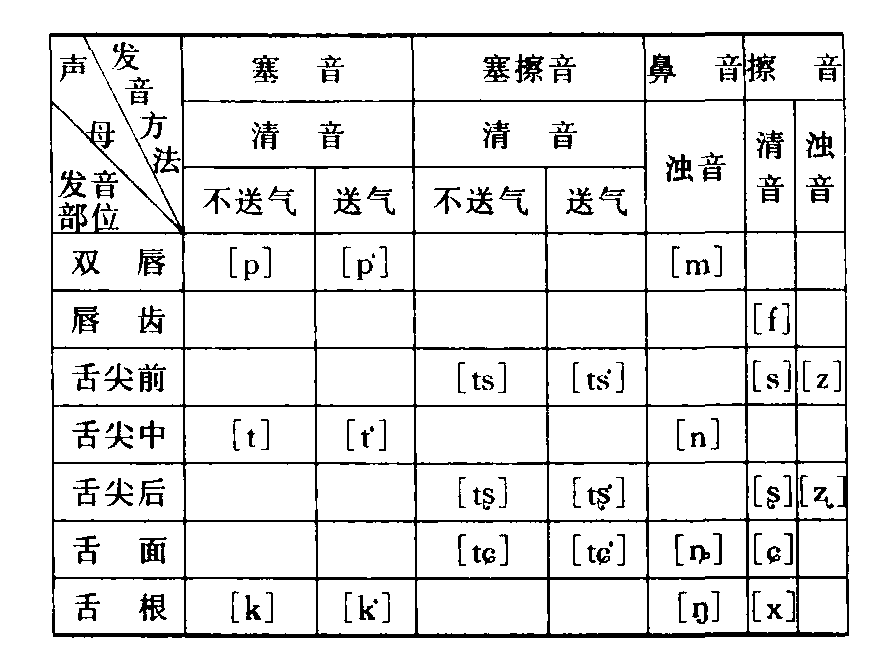四川话语音
四川话的声母、韵母和声调系统。通常以成都话语音 (参见成都话) 为代表。四川话语音内部有较大的一致性,但是各地仍有一些差异。
综合各地方音,声母共24类 (包括零声母),有辅音声母23类。详见下表。

都江堰、彭州、新都、西充等地声母最多,包括上述全部24类; 自贡、内江、仁寿、巴中、仪陇等地没有 [z] 类; 西昌、会理、盐边、米易、筠连等地没有 [z]、 [] 两类; 其余地区一般没有[
 ] 、 [
] 、 [ ]、 [
]、 [ ]、 [
]、 [ ], 如成都、温江、绵阳、 永川、 汉源等地, 有的还没有 [], 如重庆、 万县、涪陵、达川、乐山、广元等地,声母多在19类~20类。声母最少的是奉节、巫溪,还缺 [f],只有18类。 全省各地都有的声母只 [p]、 [p]、 [m]、[t]、 [t]、 [n]、 [ts]、 [ts]、 [s]、 [tʨ]、 [tʨ]、[
], 如成都、温江、绵阳、 永川、 汉源等地, 有的还没有 [], 如重庆、 万县、涪陵、达川、乐山、广元等地,声母多在19类~20类。声母最少的是奉节、巫溪,还缺 [f],只有18类。 全省各地都有的声母只 [p]、 [p]、 [m]、[t]、 [t]、 [n]、 [ts]、 [ts]、 [s]、 [tʨ]、 [tʨ]、[ ]、 [k]、 [k]、 []、 [x]、[∅] 17类。
]、 [k]、 [k]、 []、 [x]、[∅] 17类。韵母42类 ([æ]、 [iæ]、[uæ] 为 [a]、 [ia]、[ua] 在入声中的变体)。详见下表。

没有一个地区具有全部上述韵母。韵母最多的是黔江话, 只缺 [iæ]、 [ɔ], 有40类; 屏山、 宁南两地各只31类,是韵母最少的地区; 其余地区韵母多在36类左右。各地都有的韵母只有18类:[a]、 [o]、 [
 ]、 [ai]、[ei]、 [au]、 [əu]、 [ən]、[
]、 [ai]、[ei]、 [au]、 [əu]、 [ən]、[ ]、[i]、[ia]、[iau]、 [ian]、 [in]、 [u]、[ua]、[uai]、[uei]。就四呼而言,绝大部分地区四呼俱全,中江、西昌、宁南等地缺撮口呼。
]、[i]、[ia]、[iau]、 [ian]、 [in]、 [u]、[ua]、[uai]、[uei]。就四呼而言,绝大部分地区四呼俱全,中江、西昌、宁南等地缺撮口呼。声调5类: 阴平、阳平、上声、去声、人声。2/3的地区只有前四类,如成都、重庆、万县、达川、绵阳、广汉等地; 1/3的地区还有入声,如温江、乐山、宜宾、西昌、江津、西充等地。就调型、调值而言,阴平一般为高平调,调值多为55,如成都、重庆、万县、达川、南充等地; 少数地区为44,如峨眉、夹江、江油、西昌等地。阳平一般为低降调,调值多为21,如成都、重庆、南充、遂宁等地,或者为31,如自贡、内江、新都、永川、合江等地; 个别地区为高降调,如西昌为52,冕宁为41,高县为42; 还有少数地区念低升调,如达川、丰都、忠县为12; 个别地区念降升调,如万县为213。上声多为高降调,调值多为42,如重庆、内江、万县、达川、宜宾、雅安等地,或者为53,如成都、自贡、剑阁、广安等地; 个别地区是高升调,如冕宁为35。去声近3/5的地区为升调,调值多为13,如温江、绵阳、乐山、泸州、中江等地,或者为14,如西充、简阳等地,或者为24,如西昌、遂宁、资中等地; 2/5的地区为降升调,调值多为213,如成都等地,或者为214,如重庆等地; 个别地区为低平调,如西昌为11。普遍有比较明显的两种变调现象: 阳平字重叠构成名词的,后一字变读阴 平,如 “毛 毛”[mau2mau2]” 读如 “毛猫[mau2mau1]”; 去声字重叠构成名词的,不少地区后一字也变读阴平,如成都、重庆、万县等地将 “洞洞[
 ]” 读如“洞东 [
]” 读如“洞东 [ ]”, 有的地区前一字变读阳平, 如峨眉话将 “帕帕 [pa4pa4]读如 “爬帕 [pa2pa4]。
]”, 有的地区前一字变读阳平, 如峨眉话将 “帕帕 [pa4pa4]读如 “爬帕 [pa2pa4]。四川话语音和普通话相比,同大于异。主要差异在于: 声母方面: [n]、[l] 不分,普通话的[n] 和 [l], 四川话全念成 [n] 或鼻化的 [
 ];大多没有卷舌音,普通话的卷舌音念成平舌音,有的地区有卷舌音,但范围比普通话小; 普通话 [x]拼 [u] 韵的,四川话普遍念成 [fu]; 四川话有两个普通话所没有的声母 []、 []。 韵母方面: 四川话鼻音尾韵比普通话少,高元音后只有前鼻音,没有后鼻音, 普通话 [
];大多没有卷舌音,普通话的卷舌音念成平舌音,有的地区有卷舌音,但范围比普通话小; 普通话 [x]拼 [u] 韵的,四川话普遍念成 [fu]; 四川话有两个普通话所没有的声母 []、 []。 韵母方面: 四川话鼻音尾韵比普通话少,高元音后只有前鼻音,没有后鼻音, 普通话 [ ]、 [
]、 [ ] 四川话普遍念成[ən]、 [in]; 没有普通话的 [γ]、 [uo], 有普通话所没有的 [iai]、[ue]、[yo]、[yu] 等韵。声调方面: 调类同普通话基本上一一对应,只是1/3的地区多入声一类,2/3的地区跟普通话调类一样,只是古入声字不分别归入阴、阳、上、去四声,而统归入某一调类,其中大部分地区统归阳平,少数地区统归去声或阴平。就调型、调值而言,阴平同普通话基本一致,阳平普遍较普通话低而平,上声、去声多数地区听起来同普通话刚好颠倒。儿化韵不少地区都比普通话简单, 只有 [
] 四川话普遍念成[ən]、 [in]; 没有普通话的 [γ]、 [uo], 有普通话所没有的 [iai]、[ue]、[yo]、[yu] 等韵。声调方面: 调类同普通话基本上一一对应,只是1/3的地区多入声一类,2/3的地区跟普通话调类一样,只是古入声字不分别归入阴、阳、上、去四声,而统归入某一调类,其中大部分地区统归阳平,少数地区统归去声或阴平。就调型、调值而言,阴平同普通话基本一致,阳平普遍较普通话低而平,上声、去声多数地区听起来同普通话刚好颠倒。儿化韵不少地区都比普通话简单, 只有 [ ]、 [
]、 [ ]、 [
]、 [ ]、[
]、[ ]四类。
]四类。